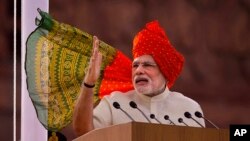As Indian Prime Minister Narendra Modi is set to make his inaugural visit to the White House later this month, there is cautious optimism in Washington on improving relations between the United States and India, which stalled earlier this year because of diplomatic tensions, according to analysts.
“I think it’s quite hopeful, but I think there’s also a certain sense of, having learnt from the past, pragmatism [and] realism,” said Tanvi Madan, director of the India Project at the Brookings Institution, a Washington D.C.-based think tank.
The visit, which will take place September 29-30, is likely to focus on economic relations between the two countries, but will be preceded by Chinese President Xi Jinping’s trip to New Delhi, which analysts believe could have an impact.
Focus on Economy
“Primarily what will be looked at is economic ties, defense, trade and technology exchanges,” Madan said.
Trade between the two has grown from only $5.6 billion in 1990 to over $63 billion in 2013, according to the U.S. Census Bureau.
U.S. Senator John McCain, a member of the Foreign Relations Committee, said the economic relations between the two countries could grow even further.
“We should also be India’s preferred partner for economic growth - spanning education, human capital and infrastructure development, and especially trade and investment,” he said.
U.S. and India have been negotiating on Bilateral Investment Treaty, aimed at helping protect and increase investments, since 2008. McCain added that in addition to this treaty, the two countries should aim for a Free Trade Agreement, which could significantly reduce trade barriers.
“Would this also be extremely hard? Of course. But the same was said of our civil nuclear agreement, and we did it,” he said, referring to a landmark civilian nuclear deal signed in 2008 after a three-decade-long U.S. moratorium.
Recent History
Despite the optimism, expectations are restrained by recent relations between India and the U.S.
“In recent months relations have suffered from some of their greatest tensions in years, and certainly since the early 1990s, when decades of turbulent bilateral ties yielded to a new era of cooperation,” said Michael Kugelman, senior program associate for South and Southeast Asia at the Woodrow Wilson Center, a Washington D.C.-based think tank.
These tensions were highlighted when an Indian diplomat, Devyani Khobragade, was arrested in New York on charges that included her paying a “legally insufficient” wage to her nanny. While the diplomat eventually returned to India, Indians were outraged at what they saw as high-handed methods used by U.S. authorities that included her being strip-searched.
According to McCain, relations between the two countries had in the past felt like a “laundry list.”
“Too often, we have been overly driven by domestic politics and overly focused on extracting concessions from one another…our strategic relationship has unfortunately devolved recently into a transactional one,” said McCain, who visited Modi in July, becoming the first high-ranking U.S. official to do so.
There is also a sense that the meeting between Modi and President Barack Obama is more about optics than substantive issues.
“My sense is that, from both the India and U.S. side, the emphasis has been more on ceremony than substance,” said Milan Vaishnav, an associate in the South Asia Program at the Washington D.C.-based Carnegie Endowment for International Peace.
Regional Relations
While not likely to be on the formal agenda, analysts believe relations between China and India will also have an impact on U.S.-India relations.
The Chinese president’s visit to New Delhi next week is a part of a trend that China takes India more seriously now, said Kenneth Lieberthal, a senior fellow at the Brookings Institution.
China has made it clear that it does not intend to slow Indian’s rise in the region, with the Chinese assistant foreign minister, Liu Jianchao, saying that China would not “use so-called military or other means to try and hem in India.”
This fits into the U.S.-India relations because U.S. Defense Secretary Chuck Hagel has also said that India does not have to choose between China and the U.S., something that would go against India’s aim of “diversified relations,” according to Madan, from the Brookings Institution.
Another part of the U.S.-India relations is a greater desire on the part of Washington for India to engage more in East Asia.
“For the U.S., the one big plus - and this is in particular light of growing American budgetary constraints - is India’s role as a security actor,” said Dhruva Jaishankar, a transatlantic fellow at the German Marshall Fund, a Washington D.C.-based think tank.
Jaishankar said that since the U.S. does not want to be dragged into conflicts in the region, even a limited Indian role would be seen as being important to the U.S.
